There are some seriously EXPENSIVE restaurants in Disney World — but which ones are worth it?
We brought you along with us for the pricey $195 experience at Monsieur Paul in EPCOT and the extravagant experience at Victoria & Albert’s (which starts at $295 per person). Today, our journey brings us to one of the most expensive restaurants in all of EPCOT — but it’s a secret spot tucked away in the Japan pavilion.
We’re talking about Takumi-Tei! Takumi-Tei is a signature restaurant in EPCOT’s Japan pavilion, located in a hidden spot over by the Mitsukoshi Department Store. It had been closed for quite some time following the 2020 COVID-19 closures but reopened later in 2022 serving up only a prix fixe omakase menu. So we stopped by to see if it’s worth your cash.
Atmosphere
Make no mistake about it, this is an absolutely GORGEOUS restaurant (once you find it, that is!). Look for a banner/sign and the door over to the right of Mitsukoshi.
From the second you step in the door, you’re greeted with a level of hospitality and attention to aesthetics that is practically unseen at most other establishments in Disney World.
You’ll see all kinds of incredible decorations around.
The restaurant is inspired by five different elements — stone…
…water…
…paper…
…earth…
…and wood.
The restaurant as a whole is inspired by Japan’s natural beauty — which is where those natural elements come in.
When we entered the restaurant, the Cast Members actually went over the theme of it with us, which was a great touch.
Then we were greeted by much of the staff, who all bowed to welcome us. Really, it’s unlike most other things you’ll experience in Disney World and a far cry away from picking up your burger at a Counter Service spot.
We were seated in the stone room, which is a small room there are only four tables in it. There is a sand Zen Garden on the wall surrounded by stone. There’s also a stone bar in this room where the alcoholic drinks are made.
The ceiling has paper light fixtures and there are beautiful wall dividers in the space as well. One of our reporters described it as “absolutely gorgeous.” It’s really one of those places where even just sitting down and admiring the decor is a treat.
There are also rooms themed to earth…
…water…
…paper…
…and wood. Each one is simple yet beautifully decorated to match its specific theme.
Even down to the chopsticks, the design and beauty shine. The chopsticks are pentagonal, sitting on the stone chopstick holder, and the placemats are very thin paper with gold specks in them that are beautiful.
The napkins add another pop of color with their orange design.
Reservations
Before we dive into the menu, let’s talk about reservations quickly. As of the time this review is published, Takumi-Tei is only offering seating for a limited number of walk-up guests from Thursday through Monday from 5PM to 7:30PM.
If you want to eat here, head to the desk outside the restaurant and let them know you’d want a table. They will then give you options for times during the evening. We walked up to the counter a little before 5 and the Cast Member appeared just a few minutes before that opening time. We were able to quickly grab a table for 5:15PM, but obviously, that can vary on crowds and demand.
When you request your seating time, you’ll provide your phone number and give them the usual check-in details (like information about your dietary needs or a special occasion you might be celebrating). Then a text was sent when our table was ready.
Keep in mind that this is subject to change and Takumi-Tei could shift to accepting reservations in the future. Be on the lookout for updates from us and see what the situation is like during your trip.
Alright, now let’s get to the menu!
Menu
Previously, Takumi-Tei offered omakase multi-course menu options as well as a la carte items. As of its reopening, however, the restaurant only offers 2 omakase multi-course menus.
There is an omnivorous option for $250 per person and a plant-based version for $150 per person. So, yes, it’s expensive!
As the menu explains, omakase means “I leave it up to the chef.” It’s meant to be an experience where the chef creates a multi-course meal. That means the menu can change, so keep in mind that the items we got today might not necessarily be the items available during your trip.
The “Kiku” or omnivorous omakase includes the chef’s selection of seasonal appetizers; nigiri and sushi roll; sashimi; your choice of a wagyu steak, roasted duck, or seabass; shirumono (essentially like a soup); and green tea accompanied by your pick of dessert.
The “Hasu” (plant-based) experience is cheaper and comes with slightly less — there is an appetizer set; nigiri and sushi roll with vegetables; deep-fried tofu; a Yuba roll; vegetable tempura; and green tea with your pick of dessert.
There is also a beverage menu.
You can add a cocktail, whiskey, sake flight, or other drink to your meal.
There are non-alcoholic options too.
Note that these are separately priced (not included in the omakase prices).
Now, let’s get to those eats!
Eats
We had two of our team members eat here — one did the omnivorous menu and the other tried the plant-based menu. Keep in mind that the items below are what we were served, but menu items can change!
Omnivorous Omakase
Course 1 — Zensai Moriawase (Appetizer Platter)
This course was made of the Chef’s selection of seasonal appetizers.
Our appetizers included a crab salad which our team member said was everything they could have hoped for.
The greens were wonderfully crunchy with the lightest soy dressing on them, while the crab was easy to eat, tasted buttery, and was well seasoned. We will say that it did have an extra touch of fishiness that could be a turn-off to some, so just keep that in mind.
The uni (sea urchin) was probably the most challenging thing on the plate. Texturally, the sea urchin was super soft and it had a nice umami flavor to it. The accompanying items had a nice acidity that helped tone down the big flavors of the urchin. But this definitely had some of that fishy flavor so beware.
The seaweed was very briny and the roe on top was big enough to cause a visceral popping sensation. When they burst, they tasted like sea water. While our reporter enjoyed it, even they shared that they didn’t think they’d have been able to eat a portion any bigger than what was served.
We also got a tofu dumpling that had a surprising texture. It tasted almost as if it was vegetable broth in a more solid form with a pudding-like texture. It did melt in your mouth though, which was nice.
The edamame was well-cooked and worked as a nice, fresh, and perhaps more “safe” addition to the plate.
Then it was time for course 2.
Course 2 — Sushi
The sushi was surprising in the best way possible. Our reporter shared that this was quite possibly one of the BEST plates of sushi they have ever had.
Our reporter shared that they often go to Morimoto Asia in Disney Springs (a big favorite of ours here at DFB) to get their big sushi platters. But the pieces of nigiri here were on another level.
The sushi (circular item in the back left), on the other hand, we would say is about equivalent to Morimoto Asia. Note that these pieces were preseasoned with the soy sauce and we think that made a big difference as it eliminated the risk of us “overseasoning” the sushi with too much soy sauce.
The yellowfin tuna (bottom left) was one delicious piece of fish. It was the one that tasted the most like what you’d expect sushi to taste like, with a piece of fish that carried strong fishy flavors. And it had an almost buttery texture that was phenomenal.
Then we had the scallop sushi, which was surprising! The scallop had an almost citrusy flavor to it that balanced out the wasabi very well.
Our favorite, however, was the last piece (top) which was the eel. The eel was incredibly tender and so flavorful. Even if you haven’t had eel sushi before, we’d highly recommend getting it here.
The sushi roll on the plate had a lot going on with some egg souffle and other elements. It almost felt like we were eating that three-course dinner chewing gum from Willy Wonka! Our reporter put the whole thing in their mouth and was hit with so many flavors.
This was extremely tasty, but the most “mundane” in terms of the overall flavor profile. It tasted more similar to something we’ve had at other sushi restaurants. But, don’t get us wrong, it was still VERY good.
Course 3 — Agemono (Deep Fried Dish)
Course 3 was a lobster tempura served with creamy ponzu sauce and salt (it is described as matcha salt in the menu but what we tasted was a yuzu salt). This was, as our reporter put it, the “fanciest fish stick in all existence.”
The lobster was cooked wonderfully and just fell apart (as you’d expect it to do). It managed to capture that lovely richness and butteriness of lobster, while still being fried in the lightest tempura batter.
Even if you don’t love fried foods, we think this is a winner. The frying really just adds the perfect amount of crunchiness.
The ponzu sauce was our favorite out of the accompaniments but we liked the salt as well. Combining them, though, is the way to go. Our reporter shared that they never want to eat lobster any other way ever again — so, yeah, we’d call this a WIN.
Course 4 — Sashimi
Course 4 was sashimi with seasonal fish. It was just that — a plate of raw fish — but our reporter said it was probably one of the BEST things they’ve ever eaten in their entire life.
This plate featured snapper, fatty tuna, and yellowfin tuna, and EVERY SINGLE PIECE was delightful. The snapper had a buttery texture and flavor to it that was not fishy at all.
The fatty tuna was probably our favorite — it had the richness almost of a dessert but was fantastically savory.
The yellowfin tuna had a great tuna flavor but was just a little bit more substantial/tougher when compared to the fatty tuna.
Overall, though, it was an AMAZING plate of fish and something our reporter said they’d easily come back for. Just keep in mind that they season the fish for you with soy sauce, but there is wasabi on the plate.
Course 5 — Yakimono (Grilled or Pan-Fried Dishes)
With this course, you get to pick the wagyu steak, roasted duck, or seabass. We went with the Wagyu, which is a 3oz Japanese A5 wagyu steak, curry-roasted potatoes, and roasted seasonal mushrooms.
And…surprise, surprise — we had ANOTHER winner. Considering how fish-heavy the rest of the menu is, this was a welcome difference.
The meat was fatty with a lovely marbling. You could tell the beef was of extremely high quality. It had a lovely buttery texture once you chewed into it, and it does start to melt in your mouth because of the fattiness.
The fat here doesn’t taste like the fat you might be used to seeing on a steak, like a ribeye. Instead, it really just transforms into a buttery, fatty, flavor explosion.
The mushrooms were wonderful and added another great savory flavor to the dish. The potatoes were also very good and the seasoning on them almost gave them a maple syrup flavor, without the sweetness.
There was a puree on top as well which was wonderful. It essentially was a sort of mashed potato option but VERY creamy. The sauces served with this were black sesame sauce and green leek sauce. The black sesame sauce almost tasted like everything bagel seasoning, but it did have a good amount of sweetness to it that complemented the meat really well.
Our preference, however, was the green leek sauce because it had a bit more sweetness to it and it had a sharpness that helped cut through some of the fattiness of the meat.
Course 6 — Shirumono (Soup)
Course 6 was made of a seasonal broth. Ours was a miso soup with tofu, mushrooms, and scallions.
This was a very good and warm miso soup, which came in a serving size that was perfect — not too big and not too small.
In terms of flavor, it was interesting. It tasted almost like it had the spiciness of ginger incorporated into it, which was a nice complement to the miso and it really elevated the miso soup.
Given how much we had already eaten at this point, we were starting to feel full but not to the point of being uncomfortably full, which was nice. Sometimes multi-course desserts like this can leave you feeling like you’ll need to be rolled out of the restaurant, but this was different — in the best way possible!
Course 7 — Ocha to Kanmi (Tea and Sweets)
Finally, we get to the tea and dessert course! For this, you get green tea and your choice of a chestnut creme brulee, strawberry yuzu sorbet, or monaka daifuku.
We opted for the Monaka daifuku with ice cream and kinako crumble, per the server’s recommendation. The server explained that it is a more traditional Japanese dessert. (Bokksu describes daifuku as a popular type of Japanese candy — it’s a type of mochi that usually has a red bean paste filling. Monaka is another type of Japanese sweet.)
The mochi was soft and gooey with the perfect ratio of red bean paste to rice dough. The server told us to put the mochi between the rice crackers and eat it like a little sandwich, which was a fun tip. The rice crackers were basically ultra-thin rice cakes, so they weren’t tremendously flavorful, but they did add a great crunch to the soft mochi.
The kinako (roasted soybean flour) crumble had an interesting flavor to it — almost like a fine sugar cookie had been mixed with a graham cracker. The crumble was very fine and it went really well with the ice cream, serving almost as a sort of pie crust.
The fruit included was strawberries and sliced grapes. Our advice would be to eat this all together. Take a bite of your mochi sandwich, then eat a spoonful of the ice cream, and get some of the crumble and fruit. For us, it was like the scene in Ratatouille where Remy eats the cheese and strawberry together. The blending of flavors was fantastic and wonderfully light — serving as the perfect ending to the meal.
Note that there is some matcha on the plate, but don’t let that scare you away if you hate matcha. Our reporter was able to eat around it for the most part. And that brings us to the end of the omnivorous omakase.
Now, let’s dive into the plant-based version.
Plant-Based Omakase
Course 1 — Zensai Moriawase (Appetizer Platter)
This first course was made of the chef’s selection of a few appetizers.
The dumpling we got was almost like a pudding, but savory! Sesame was the flavor we tasted the most. Just note that picking this up can be a bit tricky. There was a little dot of wasabi on it that we would have liked to have spread a bit more evenly, but the consistency of the bun didn’t quite allow us to do that so keep in mind that one spot may have a stronger wasabi flavor than others.
The seaweed salad we got as part of the appetizers was VERY fresh, extremely light, and so refreshing and cool. It was absolutely delicious. One piece of it had a stronger fish flavor than the others, but it was nice to get a single bite of it. It didn’t overpower the dish, which was nice. The majority of the salad was cucumber, and the dressing was slightly vinegary and salty (but not overly so). Overall, this was a great appetizer.
We also got edamame with this appetizer course and our reporter shared that it was some of the BEST edamame they’ve ever had!
Course 2 — Sushi
Course 2 brought us nigiri and rolls made with seasonal vegetables.
There was a red pepper roll that, again (you’ll sense a trend here) had some of the most delicious red pepper our reporter has ever tasted in their entire life. The roll really allowed that red pepper flavor to shine, which was wonderful.
We also got a shiitake mushroom roll. This one had a rich, sweet-and-savory sauce which was wonderful. It was almost like a barbecue sauce in a way because of its balance of sweet and savory flavor profiles.
We also got an asparagus roll. This had a seaweed flavor that came through upon the first bite, but then something within the roll exploded and provided a suddenly fruity (yet still savory flavor). It turns out that the lovely fruit flavor was from the plum that was included in the dish! It was a fun surprise and wonderful addition to this roll.
The last roll we got was a soy wrap with avocado. It was considerably less flavorful than the other rolls but still served an important purpose as a light and refreshing palette cleanser.
Course 3 — Shusai
The shusai course featured deep-fried tofu, black rice, carrots, seasonal mushrooms, and tsuyu dressing. (The Food Network has a recipe for a tsuyu sauce that includes dashi, soy sauce, and mirin.)
The fried tofu almost had the effect of a french toast. There was a sweet-and-savory sauce on top and around it that almost tasted like cola — giving this dish a sort-of syrup and french toast vibe, but in the most elevated way possible and with a savory twist!
The black rice serves as a hearty base for the dish, and the seasonal mushrooms were delicious. We also got some micro greens that added a nice sense of freshness to the plate. Plus there was another element to the dish that appeared to be pickled in curry and was a very exciting surprise. The ingredients in this dish really worked together beautifully.
Course 4 — Yuba Roll
Course 4 was a yuba roll which had beancurd skin rolled with daikon, cucumber, and miso with yuzu kosho dressing. (Mashed explains that yuba is “the skin that forms on hot soy milk.”) (According to bon appetit, yuzu kosho is a “pasty Japanese condiment made from fresh chiles (most often green or red Thai or bird’s eye chiles) then fermented with salt along with zest and juice from yuzu, a tart and fragrant citrus fruit that grows in East Asia.”)
This was a very flavorful and herbaceous roll. It reminded us of the soy paper and avocado rolls from earlier in the meal, but this one was a LOT more interesting since it had a flowery taste.
The sauce (the yuzu kosho dressing) was very light and had a citrus flavor to it, though it wasn’t the most flavorful thing in the entire world.
Course 5 — Yasai Tempura (Vegetable Tempura)
Course 5 features seasonal vegetable tempura served with warm soba noodles.
The soba noodles were made with yuzu (we meet once again!) and were SO interesting and delicious.
Yuzu is a tart citrus fruit — almost like a lemon — and the flavor of the yuzu was really the predominant flavor in the soba noodle dish. That makes it really unique and was unlike anything we’d ever had before.
The vegetable tempura included in this course truly BLEW US AWAY. Our reporter who had the plant-based menu shared that it was the BEST thing they had out of the entire meal (up to this point in the meal, anyway) — to the point where they said they wished they could eat it every single day!
The salt used in the dish was a citrus salt, but the flavor was unique — almost as if a lemon and tangerine had a lovely, citrusy baby.
Course 6 — Ocha to Kanmi (Tea and Sweets)
Finally, we get to the last course! This comes with green tea and your pick of a strawberry yuzu sorbet or monaka daifuku.
We opted for the sorbet — it was a strawberry yuzu sorbet served over a plant-based shiso (beefsteak plant) jelly. The yuzu sorbet was crumbled, almost like little pebbles, and then frozen — which made it a bit more interesting than your regular sorbet!
On the side of the bowl, there was an orb and a disk made of shiso jelly. On its own, the shiso jelly tasted like freshly cut grass — which is certainly an interesting flavor.
The yuzu sorbet was bright and cheery, but we barely tasted the strawberry. Instead, the yuzu was the predominant flavor.
But things changed when we mixed the various elements together. We grabbed a piece of the shiso jello and ate it with the yuzu sorbet rubble (along with a dusting of the rose sugar that was garnishing the rim of the bowl) and the whole flavor profile changed.
It was DELICIOUS! It gave us a white cherry vibe which we loved!
Drinks
Finally, from the drinks menu, we ordered the Kami, which is a signature cocktail that costs $15. This is made with KI NO BI Gin, Nigori “Sacred Mist” Sake, Lychee Calpico, and Lychee.
Our reporter who tried this absolutely LOVES lychee cocktails, so they had to give this a try. In a word, it was…delicious! The cocktail was light and fruity. It was a touch on the sweet side, but not in an overly sugary way — more in a naturally sweet way.
It did have a bit of the burn from the gin, but we didn’t taste the more natural elements of the gin (like the pine tree taste). Instead, the lychee was the main flavor (it did have a lychee in the cocktail so that makes sense!).
In terms of looks, we loved the tiny paper crane that was folded on the end of the chopstick — it added a really nice touch! Britannica explains that “kami” is defined as an object of worship in indigenous religions of Japan — it’s often translated to god but also includes other forces of nature.
And with that, we end our EXTENSIVE meal at Takumi-Tei. Let’s go over some final thoughts.
Nosh or Not
Visit Takumi-Tei if:
- You love Japanese food or sushi — This really highlights sushi and Japanese flavors in a spectacular way
- You’re looking for a really spectacular and surprising meal in Disney World — Some of the dishes our reporters had here are ones they’ve described as the BEST they’ve ever had in their lives. It is a splurge for sure, but the quality is incredible
- You want to celebrate a very special occasion — The atmosphere here is lovely and it would be great to celebrate an engagement or other special news
- You’re an adventurous eater — If you love to try new foods and be surprised by flavors you may have never experienced before, this is the place to do it — especially for plant-based eaters. Plant-based eaters who love citrus and adventurous Japanese food (which can sometimes be difficult to find for those who eat a plant-based diet) should absolutely visit.
Skip Takumi-Tei if:
- You are a picky eater or have picky eaters in your party — This is a menu created by the chef and some of the flavors/ingredients may be far out of your comfort zone.
- You’re not wanting to commit to a 3-4 hour dinner during your EPCOT day — Our meal took about 4 hours. Granted, we were snapping LOTS of photos. Still, you should expect to spend an extended amount of time here.
- You’re on a tight budget — This is definitely a SPLURGE!
- You hate citrus — This comment is mainly for the plant-based menu, which featured a lot of citrus-heavy flavors. If you are not a fan of citrus, steer clear. Several of the dishes on the plant-based menu featured yuzu as a predominant flavor. If you don’t like citrus, that’ll be very offputting for you.
Overall
Overall, our omnivorous eater shared that this was one of the BEST meals they’ve ever had (including meals outside of Disney). Granted, that member of our team loves Japanese food, so this was a great fit for them.
The service was impeccable, the environment is incredibly serene and beautiful, and every course felt like it had been thoughtfully put together. The food was truly just as beautiful and intentional as the food at Victoria and Albert’s. Where Victoria & Albert’s beats Takumi-Tei is on the level of presentation when an item is brought out and some of the rarity of the items being served. But, Takumi-Tei really holds its own when it comes to extravagant meals.
Is it worth $250? It depends. If you’re a huge fan of Japanese cuisine, then you might find this to be worth every penny (one of our reporters certainly felt this way).
We especially loved that the meal left us satisfied without feeling overly full or stuffed to the point of being sick. If you’re a really picky eater though, beware since there really aren’t options for substitutions.
As fancy EPCOT restaurants go, Monsieur Paul might be a safer recommendation since the dishes there can feel a bit “safer.” But if you’re an adventurous eater, Takumi-Tei is the way to go.
What do you think? Would you spend the money on this meal? Tell us in the comments.
With DOZENS of places to eat at Disney World, we know it can be tough to plan your meals. That’s why we wrote the DFB Guide to Dining at Walt Disney World. We have reviews, pictures, and details about every restaurant all in one digital download – along with ALL of our best tips and strategies from decades of Disney World trips.
We’ve got a special discount code for DFB readers, too!
Use WDW2023 at checkout for 25% off!
Need Disney Restaurant Advice? We’ve Got EVERYTHING You Need to Know
The ONLY Disney Dining Planning Tool You’ll Need Is Here – Get the DFB Guide to Walt Disney World Dining!
See Our Complete Disney World Restaurants Guide
The Best Magic Kingdom Restaurants
The Best EPCOT Restaurant Restaurants
The Best Hollywood Studios Restaurants
The Best Animal Kingdom Restaurants
The Best Disney Springs Restaurants
Check Out Dozens of Disney Dining Tips and Tools
Learn All About Tipping at Disney Restaurants
How to Use Mobile Order in Disney World
Join the DFB Newsletter to get all the latest Disney food news right in your inbox! Click here to Subscribe!
Would you eat at Takumi-Tei? Tell us in the comments!














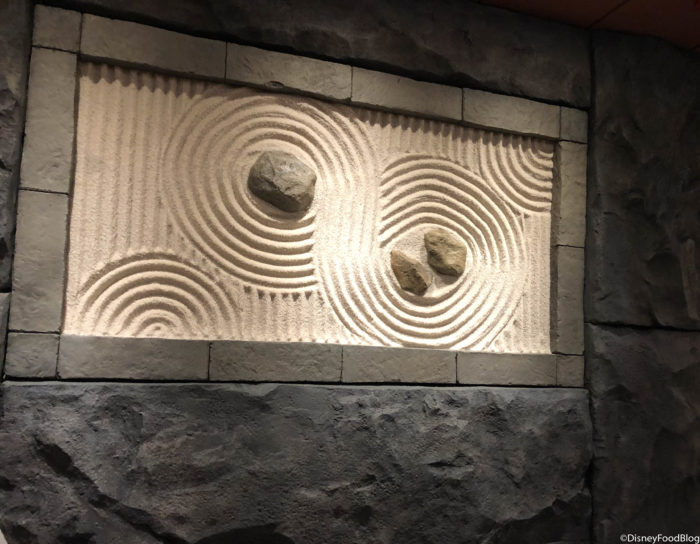















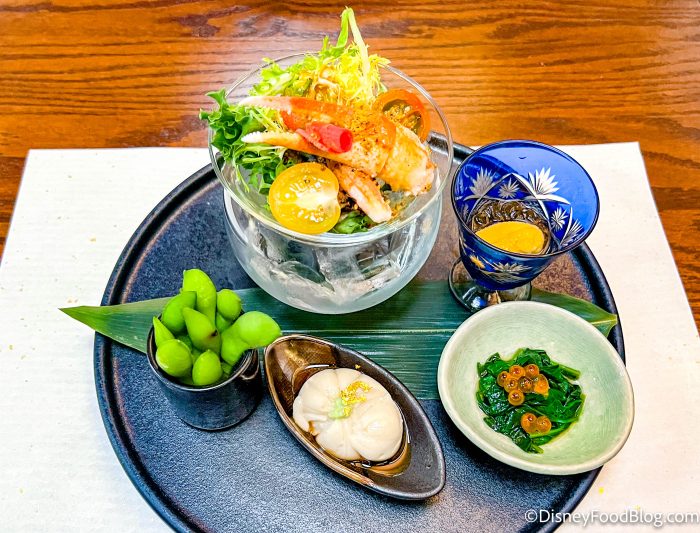










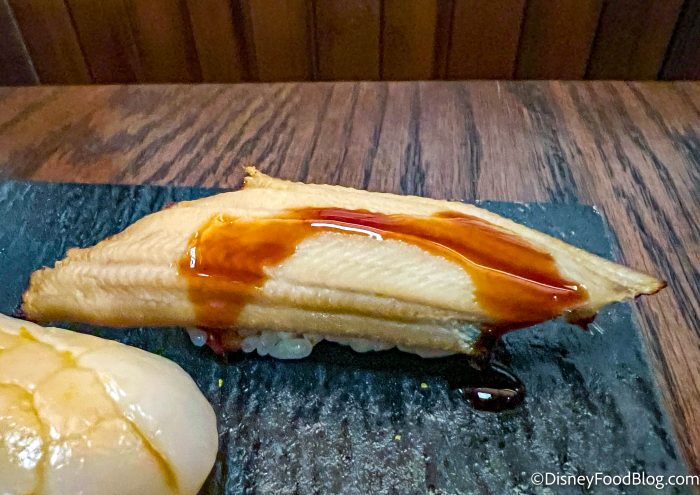


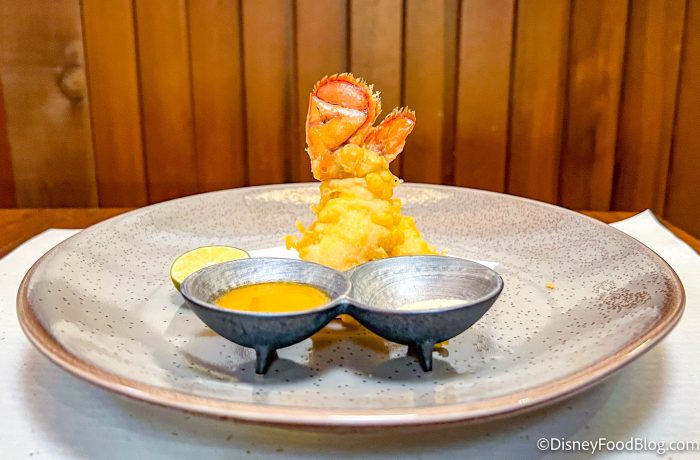


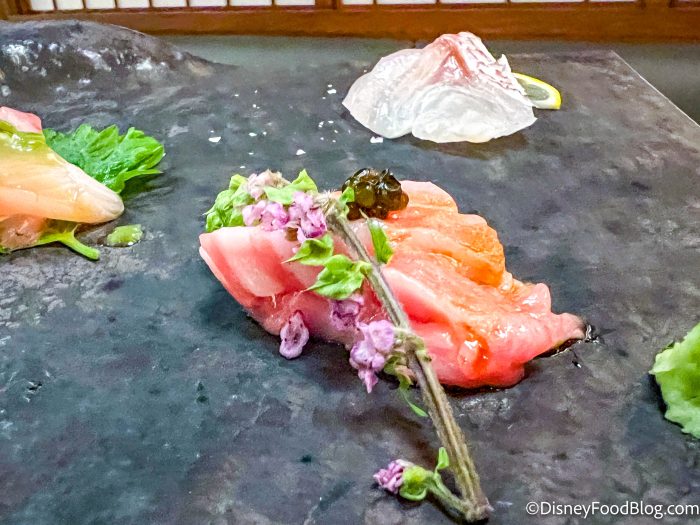
















































 Our handy (and portable!) ebook guides make sure you get the best deals and can plan a vacation of a lifetime.
Our handy (and portable!) ebook guides make sure you get the best deals and can plan a vacation of a lifetime.

Thank you for the detailed review. Takumei-Tei does not look at all appealing to us. We will stick with Teppan Edo.
We ate their recently when both my wife and son noticed that there was a small stand outside and someone was actually standing at it. We inquired about Takumi Tei and whether it was opened that evening because we passed by earlier and it was empty. We did find out that the restaurant was only open 5 days a week excluding Tuesday and Wednesday.
We would agree with your review except the Wagyu was not tender at all. Simply trying to bite into it was difficult and we could not use our chopsticks for that. At $250 for the “Kiku” and $150 for the plant-based Omakase, we walked away disappointed.
My wife and I were fortunate enough to eat at Takumi-Tei in 2019. We still talk about the amazing food and service. Definitely an experience we will never forget.
Great review! Is the chef able to accommodate gluten-free diners?
Hi Crissy! Yes, they will usually be able to accommodate any allergies.
Hi! Thanks for the review. I was able to get a reservation so they must have started taking them. Thought you would be interested in knowing this. I am curious as to when they might bring back the a la carte menu. I am excited I just do not know if I should choose the wagu, duck, or sea bass. Any insight? Thanks as always for being the best out there for a wealth of information
The new menu is not as appealing as it’s original. This restaurant went from the #1 priority to now waiting for the menu to change before returning.
I’m sorry I missed it with the original menu ad I could have picked the things I like to eat and those I don’t. I don’t eat raw fish but at a fine Japanese restaurant in Las Vegas from a 2 star Michelin chef out of Singapore I have no trouble putting together a wonderful fully cooked menu that I enjoy immensely. Hopefully we will get ala carte back here again in the near future and then I ca. give it a try.